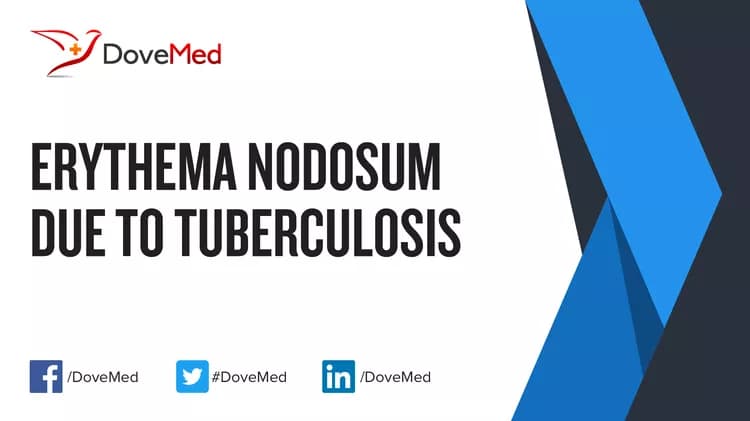What are the other Names for this Condition? (Also known as/Synonyms)
- Erythema Nodosum due to TB
- Tuberculosis-Associated Erythema Nodosum
What is Erythema Nodosum due to Tuberculosis? (Definition/Background Information)
- Erythema nodosum is a skin condition that causes painful red subcutaneous nodules. It may be caused by numerous factors including certain medications, infectious diseases, pregnancy, inflammatory bowel disease, blood cancer, and many other disorders
- Erythema Nodosum due to Tuberculosis occurs against a background of tuberculosis (TB), a contagious infection caused by the bacterium Mycobacterium tuberculosis. The disease is characterized by the formation of nodules (tubercles) in the affected tissues
- It is reported that erythema nodosum may occur during the early stages of tuberculosis, before the onset of significant symptoms of TB. In some cases, individuals with latent TB may also develop erythema nodosum
- The nodules in Erythema Nodosum due to Tuberculosis may occur on the legs and the arms. The signs and symptoms of tuberculosis may include persistent cough, fever and chills, fatigue, and wheezing
- Adequate treatment of the underlying infection can help resolve Erythema Nodosum due to Tuberculosis. With appropriate treatment of tuberculosis, the prognosis of erythema nodosum is good in a majority of individuals
Who gets Erythema Nodosum due to Tuberculosis? (Age and Sex Distribution)
- Erythema Nodosum due to Tuberculosis may occur at any age. However, young adults are known to develop tuberculosis more often
- Both males and females are affected, although erythema nodosum is more often seen in females
- It can affect individuals of any ethnicity, race, or region
- Tuberculosis is more common in Asia, Africa, and parts of South America
What are the Risk Factors for Erythema Nodosum due to Tuberculosis? (Predisposing Factors)
- Individuals with tuberculosis are at an increased risk for developing Tuberculosis-Associated Erythema Nodosum
- It is reported that individuals with a weak immune system have an increased risk for the condition
It is important to note that having a risk factor does not mean that one will get the condition. A risk factor increases one’s chances of getting a condition compared to an individual without the risk factors. Some risk factors are more important than others.
Also, not having a risk factor does not mean that an individual will not get the condition. It is always important to discuss the effect of risk factors with your healthcare provider.
What are the Causes of Erythema Nodosum due to Tuberculosis? (Etiology)
- Research scientists believe that Erythema Nodosum due to Tuberculosis is caused by an immunological response of the body to tuberculosis infection. The nodules form on skin as a reaction to the underlying condition
- Tuberculosis (TB) is caused by Mycobacterium tuberculosis (a rod-shaped bacterium). The infection usually occurs in the lung, but can also occur in other areas of the body
- TB is a contagious condition that is usually transmitted from one infected individual to another via contaminated air (through respiratory droplets)
What are the Signs and Symptoms of Erythema Nodosum due to Tuberculosis?
The signs and symptoms of Erythema Nodosum due to Tuberculosis may include:
- Presence of nodules beneath the skin that is noted even before other symptoms of the underlying tuberculosis manifest
- They begin as flat, firm and red lumps measuring up to an inch on the body
- After a few days, the nodules turn purple; weeks later, they become flat and brownish patches
- The nodules may be present on any part of the body, especially on the legs, thighs, and buttocks
- The symptoms of tuberculosis may include persistent cough, breathing difficulty, fever and chills, chest pain and cough
How is Erythema Nodosum due to Tuberculosis Diagnosed?
The following procedures may be used to diagnose Erythema Nodosum due to Tuberculosis:
- Thorough evaluation of the individual’s medical history and a complete physical examination
- Tuberculosis skin and blood tests
- Chest X-ray
- Tissue biopsy: A skin/tissue biopsy is performed and sent to a laboratory for a pathological examination. The pathologist examines the biopsy under a microscope. After putting together clinical findings, special studies on tissues (if needed) and with microscope findings, the pathologist arrives at a definitive diagnosis
- The diagnosis of Tuberculosis must be suspected and confirmed
Many clinical conditions may have similar signs and symptoms. Your healthcare provider may perform additional tests to rule out other clinical conditions to arrive at a definitive diagnosis.
What are the possible Complications of Erythema Nodosum due to Tuberculosis?
- Major complications associated with skin lesions of Erythema Nodosum due to Tuberculosis are not reported
- However, complications are mainly observed due to the underlying tuberculosis infection and may include coughing-up blood, meningitis (mostly in children), and lung damage
How is Erythema Nodosum due to Tuberculosis Treated?
The treatment options of Erythema Nodosum due to Tuberculosis include treating the underlying tuberculosis, which is undertaken through:
- Administration of antibiotics for a period determined by the healthcare provider
- Symptomatic and supportive therapy, if needed
Generally, a specific treatment for the skin lesions is not required. On treating the underlying condition, erythema nodosum skin lesions usually disappears.
How can Erythema Nodosum due to Tuberculosis be Prevented?
The prevention of Erythema Nodosum due to Tuberculosis is linked to preventing tuberculosis, which may be enabled through the following measures:
- Avoiding close physical contact with untreated individuals with tuberculosis (TB); getting treated, in case of contact with tuberculosis-infected individuals
- Undertaking early diagnosis and treatment of tuberculosis
- Getting vaccinated against TB, if in an endemic area
- Healthcare workers and individuals in close contact with the TB patients should follow strict hygiene and preventative measures
- Getting treatment for any underlying medical condition(s) that may decrease immunity in the individual
What is the Prognosis of Erythema Nodosum due to Tuberculosis? (Outcomes/Resolutions)
- The prognosis for Erythema Nodosum due to Tuberculosis is usually good with prompt treatment of tuberculosis (TB)
- However, the overall prognosis is also dependent on the underlying condition (TB) and the severity of the symptoms presented
Additional and Relevant Useful Information for Erythema Nodosum due to Tuberculosis:
- Cleaning the skin too hard with strong chemicals or soaps may aggravate the skin condition. Care must be taken avoid strong soaps and chemicals that could potentially worsen the condition
- The presence of dirt on the body is not a causative factor for the condition. However, it helps to be clean and hygienic, which may help the condition from getting worse
Related Articles
Test Your Knowledge
Asked by users
Related Centers
Related Specialties
Related Physicians
Related Procedures
Related Resources
Join DoveHubs
and connect with fellow professionals



0 Comments
Please log in to post a comment.